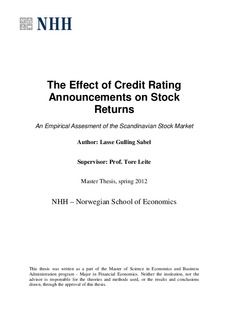The effect of credit rating announcements on stock returns : an empirical assesment of the Scandinavian stock market
Master thesis
Permanent lenke
http://hdl.handle.net/11250/169629Utgivelsesdato
2012Metadata
Vis full innførselSamlinger
- Master Thesis [4372]
Sammendrag
This master thesis aims to explain the association between changes in credit ratings and stock returns. In efficient markets, all pricing relevant information is discounted in the stock price. Hence, stock prices will not react to credit rating announcements unless the announcement conveys new information. I assess the information content of credit ratings by measuring the abnormal stock returns associated with credit rating announcements. Abnormal returns are calculated relative to two expected returns models, (i) the market adjusted return model and (ii) the market model.
I found that both upgrades and downgrades yield significant cumulative abnormal returns. Downgrades are significant on the announcement day and the pre/post-event day, in the pre-event window and the post-event window. Upgrades are significant on the announcement day and the pre/post-event day. Hence, it is evident that credit ratings do indeed convey new information to the capital markets. The results were not altered by choice of expectation model. Firms with a high current ratio experience less negative abnormal returns in case of downgrades on the event day. In the case of upgrades I found that firms with a higher debt-to-asset ratio experience less positive abnormal returns on the announcement day.
Changes in credit rating yields more negative abnormal returns for firms which are downgraded to non-investment grade, compared to firms which are not reclassified. This is especially evident in the post-event window. Reclassification did not yield any significant results for upgrades. Furthermore, this study shows that non-investment grade firms experience significantly more negative abnormal returns in case of downgrades, compared to investment-grade firms. The results are highly significant for all event windows except the post-event window.
In order to explain abnormal returns, I used a multiple regression model based on the aforementioned variables (leverage, reclassification, (non)-investment grade) and a control variable to account for market anticipation. By controlling for all the explanatory variables, I found that the current ratio had a significant effect on downgrades on the announcement day. Moreover, credit rating announcements which were not anticipated yielded cumulative abnormal returns on the pre/post-event day. In general, the multiple regressions model seems to perform poorly when it comes to upgrades.
